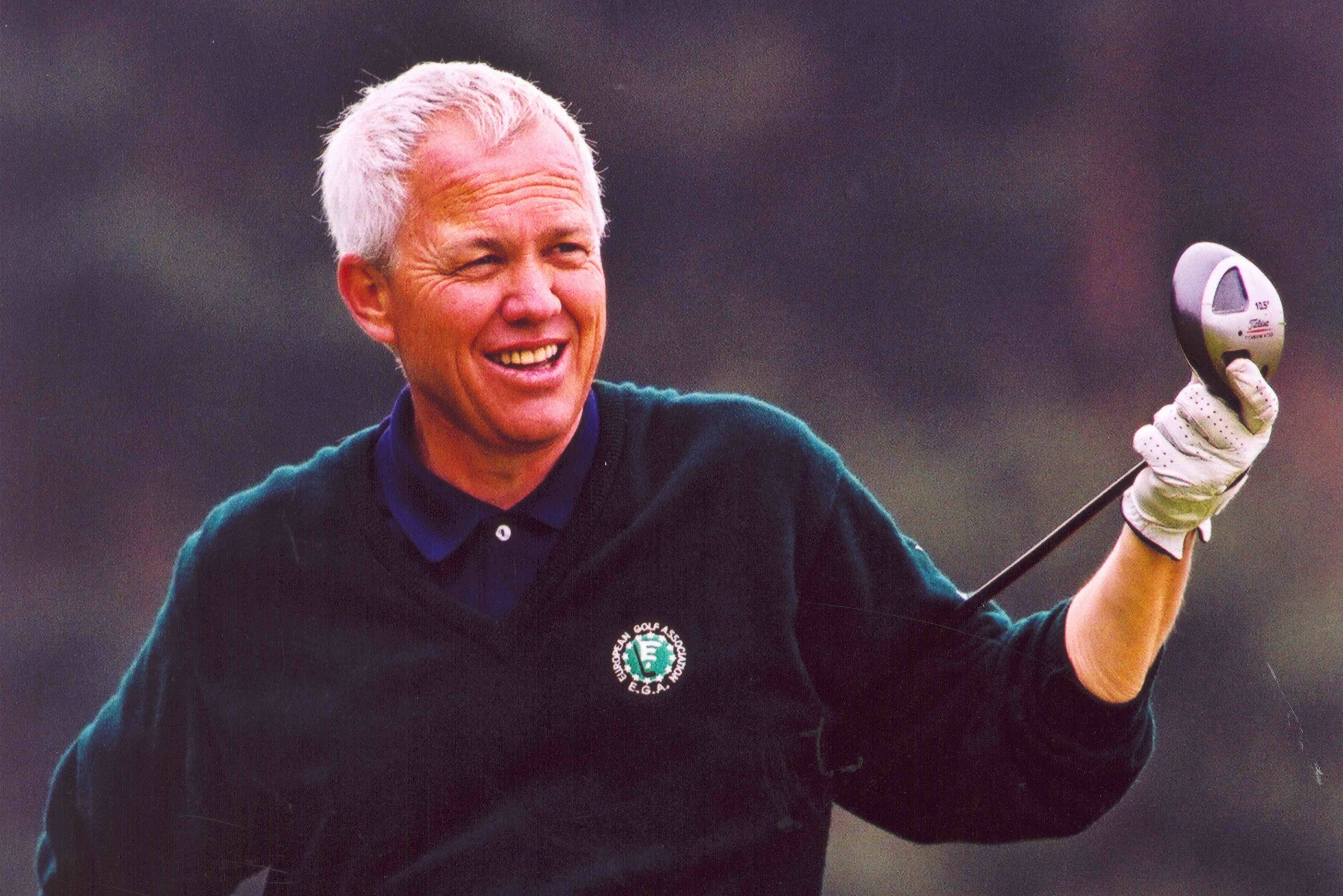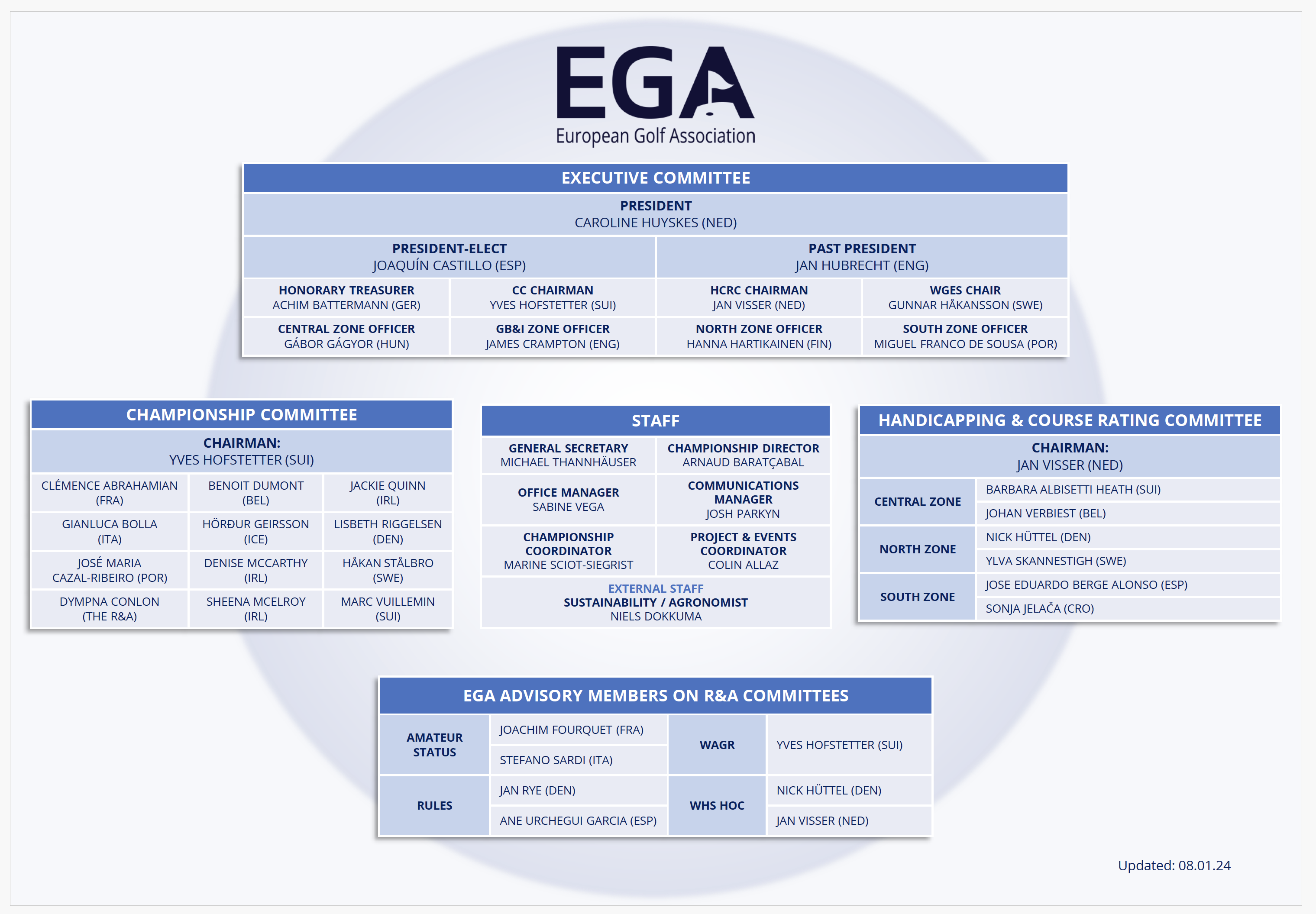Founded in 1937, the EGA’s original purpose was to foster relationships and collaboration between the existing national golf bodies in Europe and promote the sport on the continent. In its early years, volunteer delegates from around a dozen countries would meet once a year.
Fast forward to today and the EGA has grown to a substantial organisation with 50 member federations, more than 30 volunteer officials serving on multiple committees and six full-time staff.
But how and when did the association develop its current organisational structure and what does that look like today?
THE ESTABLISHMENT OF THE EGA SECRETARIAT
By the mid 1980s, the EGA had grown to have multiple committees dealing with various aspects of golf in Europe, all with purely volunteer officials and honorary secretaries. Among the committees of the time were the Executive Committee, Amateur Technical Committee (ATC) (now the Championship Committee), the Handicapping Committee, the Professional Technical Committee, and the EGA Amateur Status Committee. The first three still exist today, and form the basis of the EGA’s structure, while the latter two have since been discontinued under the EGA’s umbrella.
At the time, the EGA’s Honorary Secretary purely oversaw the secretarial work of the Executive Committee, with an office in France at the French Golf Federation helped by a part-time assistant. The other committees had their own Secretaries, meaning all of the administrative work of the EGA was carried out on an honorary basis without any centralised coordination.
At the EGA’s 1986 AGM, Jens Wester-Andersen, then President, explained to the delegates that the secretarial work of the EGA had grown to such an extent that it was too demanding to rely solely on honorary contribution. Earlier that year, the first editions of the European Amateur and Ladies’ Amateur Championships were held, adding to the administrational burden of the EGA’s activities, which now included the coordination of eight European Championships and three international matches.
A proposal to the delegates for a raise in membership fees to accommodate a new paid secretary was unanimously accepted. Following a recommendation by the Swiss delegation, John Storjohann was appointed as the first paid Secretary of the organisation.
Better known as ‘Johnny’, Mr. Storjohann was already serving Swiss Golf (then ASG) as its General Secretary when an agreement was made whereby he would share his time between the Swiss federation’s activities and the EGA’s.
In the years that followed, Johnny temporarily hosted the EGA Secretariat in his own private home, enlisting the help of an assistant in 1988. A few years later, with the association’s activities continuing to grow with the help of its new Secretary, the EGA’s budget was increased again so that its own office space could be established. In 1990, the EGA’s first centralised secretariat became active alongside the ASG’s newly leased headquarters in Epalinges, where it remains to this day.
Throughout Johnny’s dedicated 25 years of service as Secretary of the EGA, the office team slowly grew in Epalinges alongside the EGA’s growing activities. Today, the EGA’s headquarters hosts six full time employees, with additional external support in environmental sustainability.
GOVERNANCE & ORGANISATIONAL STRUCTURE TODAY
The EGA membership is solely made up of European national amateur golf associations, federations, and unions.
Founded in 1937 by delegates from 11 countries, the association has grown to 50 member federations today which are separated into four geographical zones, the North Zone, Central Zone, South Zone and Great Britain & Ireland Zone.
Today, the EGA is governed by the following bodies:
- The Executive Committee (EC)
- The Championship Committee (CC)
- The Handicapping and Course Rating Committee (HCRC)
The Annual General Meeting (AGM), followed by the Executive Committee (EC) are the highest institutional bodies of the EGA, with the secretariat in Epalinges carrying out the association’s daily operations.
The EGA has had something similar to an executive committee since its early years. The EC oversees all affairs of the association, such as developing the organisation’s strategic plans, nominating officials to serve on various committees, and takes key decisions such as the appointment of the General Secretary. Today it consists of 11 members:
- The President
- The Past President
- The President-Elect
- The Honorary Treasurer
- The Championship Committee Chairman
- The Handicapping & Course Rating Committee Chairman
- The Chairman of the Working Group on Environmental Sustainability
- 4 Zone Officers (North Zone, Central Zone, South Zone, GB&I Zone)
The President, who acts as chair of the Executive Committee, the President-Elect, and the Past President all serve two years in their respective roles, for a total of six years on the committee. All other members of the EC serve two-year terms, which are typically renewed to for a maximum of one additional term.
The latest change to the EC is the addition of the chairman of the Working Group on Environmental Sustainability. This role was previously held by the President-Elect, and since November 2023 has been given its own seat.
The Championship Committee, previously called the “Amateur Technical Committee” until 1996, primarily oversees the sporting aspects of the EGA. Today the CC is composed of 13 members, a chairman and 12 committee members.
The main role of a Championship Committee member is to facilitate the organisation and continuous improvement of EGA Championships. The committee meets twice a year to discuss and take decisions on all topics related to EGA events.
Two CC members are present at each EGA Championship and are responsible for the sporting side of the events. Their roles include overseeing the Opening and Closing Ceremonies, ensuring the EGA standards are implemented, and assisting in the operational aspects of the event.
Introduced in the early 1980s’, The Handicapping & Course Rating Committee consists of a maximum of seven members, two from each zone (North, Central and South) plus the chairman who also sits on the Executive Committee.
Up until 2019, the committee oversaw the application of the EGA Handicap System, and since then has been made responsible for the oversight, implementation, and administration of the World Handicap System (WHS) as the exclusive authorised handicapping body in Continental Europe.
MEETINGS
The committees meet multiple times throughout the year, including typically once in Lausanne in February, and at the association’s Annual General Meeting (AGM) in November.
The General Assembly during The Annual General Meeting (AGM) is the highest institutional body of the Association, which has been the case since the founding of the EGA.
The very first EGA AGMs, and many since, were held at Golf Club Grand Ducal in Luxembourg, although the meeting now takes place in November at a differing venue each year.
Reports from the different committees of the EGA & the R&A are made during the AGM. The financial report is presented to all the members by the Honorary Treasurer, and any important matters are discussed. Officers of the Association are elected or re-elected and new applications for membership are considered.
The AGM is the moment of the year where all the different officials of the EGA and member federations come together. During a few days, delegates are given the chance to share their thoughts and comments through organised workshops and zone meetings, helping foster collaboration between the different associations.



